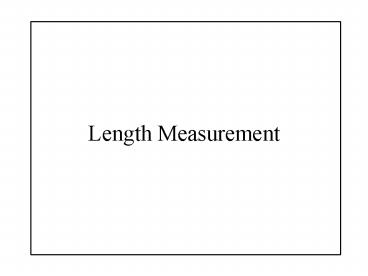Length Measurement - PowerPoint PPT Presentation
1 / 25
Title:
Length Measurement
Description:
The original Johansson gage block set consisted of 102 blocks arranged in three series. ... FLATNESS, PARALLELISM AND SURFACE ROUGHNESS TOLERANCES OF GAGE BLOCKS ... – PowerPoint PPT presentation
Number of Views:162
Avg rating:3.0/5.0
Title: Length Measurement
1
- Length Measurement
2
Length measurement I
- Issues related to measuring length
- Fundamental dimension in Engineering Metrology.
- Generally confined to simple form.
- Separation of two points in two planes or
surfaces. - Length affected by flatness and parallelism of
planes. - Surface finish and form are the two fundamental
limits for precise definition of length.
3
- Measurement of length
- Reference artifacts e.g., Gage Blocks, Ring
gages. - Small measuring instruments e.g., Vernier
Calipers, Micrometer, Height gage etc. - Comparators
- Coordinate Measuring Machines
4
Length measurement II
- Relationship to definition of meter
- Not practical to check instruments against
standards. - Gage blocks are a practical solution.
- Gage Blocks History
- In 1895, Swedish Engineer Carl E. Johansson
conceived the idea of using built-up gages
instead of several special gages for measurement. - The original Johansson gage block set consisted
of 102 blocks arranged in three series. These
were made by a specially designed lapping
process. - By proper selection of individual blocks a wide
range of different lengths could be built in very
fine increments.
5
Gage Blocks
- Purpose
- The essential purpose of gage blocks is to make
available end standards of specific lengths by
temporarily combining several individual elements
each representing a standard dimension - into a
single large bar. - Major Requirements for Gage Blocks
- The individual elements must be available in
dimensions - needed to achieve any combination of sizes
within the - designed range and graduation of the set.
- The accuracy of the individual blocks, in every
significant - respect, must be within accepted tolerance
limits. - In the built-up combination, the individual
blocks must be attached so closely to each other
that the resulting bar will have a length which,
for most practical purposes, is equal to the
added sizes of the individual blocks of the
assembly. - The attachment of the elements to each other must
be firm enough to permit a reasonable amount of
handling as a unit, yet when taken apart, the
individual pieces should be reusable without any
harm to their original size or other essential
properties.
6
Gage Block Tolerance grade ASME B89.1.9 - 197
7
Gage Blocks
The surface of the gage block viewed through an
optical flat. The straight pattern of the
interference fringes proves the excellent
flatness of the gaging surface
CROSS-SECTIONAL DIMENSIONS AND TOLERANCES OF GAGE
BLOCKS
8
FLATNESS, PARALLELISM AND SURFACE ROUGHNESS
TOLERANCES OF GAGE BLOCKS
LENGTH TOLERANCES OF GAGE BLOCKS
9
Gage block Materials
- High carbon, chromium alloyed steel
- Good hardenability.
- Minimum quenching distortions.
- Reasonable wear resistance.
- Relatively low prices.
- Easy to manufacture.
- Other properties like hardness, homogeneity and
stability have been improved. - Tungsten Carbide and Chromium Carbide
- High wear resistance.
- More expensive than steel.
- Fused Quartz
- Wear resistant.
- Can be polished to a high degree of smoothness.
- Do not produce protruding burrs when scratched in
use.
10
AVERAGE COEFFICIENT OF THERMAL EXPANSION OF
MATERIALS COMMONLY USED FOR THE MANUFACTURE OF
GAGE BLOCKS AND FOR COMPONENT PARTS IN
ENGINEERING PRODUCTION
11
Composition of typical Gage Block sets
12
Gage Blocks Method of use
- Wringing
- The steps in wringing together, rectangular gage
blocks are as below - Hold the blocks in a crosswise position.
- Exert some pressure and swivel them slightly
until they adhere to each other. - Slip the adhering blocks together into a parallel
position with slight pressure. - The wrung blocks form a single unit for the
purpose of instrument setting and measurement.
13
SUGGESTED PROCEDURE FOR SELECTING THE INDIVIDUAL
BLOCKS TO BE COMBINED INTO THE REQUIRED TOTAL
LENGTH
14
Example for a combination of gage blocks into a
specific total length. Available set of 81
blocks. Desired dimension 1.7865 inch.
15
Principle of dimensioning for limit gages
16
Gage Block Interferometry
17
Gage Block Calibration
- Gage Block comparator
- Differential measurement
- Gage Block Interferometer
18
Gage Block Comparator
19
Gage Block Interferometer
20
Gage Block Interferometry
O
Surface
S Source O Optical flat l - wavelength
21
Continued
22
Gage Block Interferometry
Pattern of fringes
Example
23
Gage Block Interferometry
Gage Length Interferometer
24
Gage Block Interferometry
Choose the mth and nth fringe, then
Length of gage l X Y (m f)l/2 nl/2 (m
n f)l/2 (m n) unknown, but being integers
their difference must be an integer, say M. l
(m n f)l/2 (M f)l/2 Suppose l is
approximated using nominal length L, L Ml/2 or
M 2L/l
25
Continued































